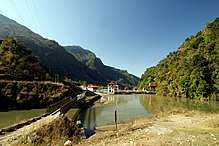Renewable energy in Nepal

Renewable energy in Nepal is a sector that is rapidly developing in Nepal.[1] While Nepal mainly relies on hydro electricity for its energy needs, solar and wind power is being seen as an important supplement to solve its energy crisis.
Hydropower
Nepal currently has an installed capacity of 1,000 megawatts (MW) coming from 88 hydropower plants across the country.[2] Of this, 441 MW is produced by 60 hydropower plants owned by independent power producers.[2] Most of Nepal's hydropower plants are run-of-the-river, which causes electricity supply to fluctuate according to the season.[2]
As of March 2018, as many as 113 hydropower plants are under construction. These plants will have a combined capacity of 3,090 MW once completed.[2]
According to one estimate, Nepal has a hydropower potential of 83,000 MW.[3]
The Nepal earthquake in April 2015 is estimated to have destroyed at least 14 hydropower dams in the country,[4] accounting for 115MW of hydropower facilities.[5] The earthquake affected 30 percent of Nepal's generating capacity at the time.[6] This resulted in suggestions for Nepal to diversify it energy mix, as well as for "short, medium and long-term energy planning to have reliable, secure and sustainable electricity provided to households, businesses and industries in the country."[5]
Solar energy
Power cuts with an average of 10 hours per day[7] have been common in Nepal and Nepal Electricity Authority[8] publishes a time table for power cuts. Solar energy can be seen as a more reliable source of energy in Nepal than the traditional electricity. Private installations of solar panels are more frequent in Nepal.
Accordingly solar energy are used properly in Nepal but we can still improve more.
Places such as Madi, Chitwan where the Electricity Authority do not provide electricity[9] because of Chitwan National Park, people there have been relying on solar power[10] for several years.
Electric vehicles
Electric powered[11] public three wheeler have been in use to reduce carbon dioxide (CO2) emissions. [12]
See also
| Wikimedia Commons has media related to Renewable energy in Nepal. |
References
- ↑ "The age of enlightenment". Nepalitimes. Retrieved 3 February 2013.
- 1 2 3 4 Adhikari, Devendra (March 18, 2018). "Hydro-powered dreams". Kathmandu Post. Retrieved 2018-04-06.
- ↑ "First man to predict 83,000 MW hydropower potential in Nepal passes away". Kathmandu Times. April 28, 2017. Retrieved 2018-04-06.
- ↑ "Nepal Earthquake Damages At Least 14 Hydropower Dams". Circle of Blue. 2015-05-05. Retrieved 2018-04-06.
- 1 2 "Diversity in power". Kathmandu Post. March 11, 2018. Retrieved 2018-04-06.
- ↑ "Nepal Earthquake Damages At Least 14 Hydropower Dams". Circle of Blue. 2015-05-05. Retrieved 2018-04-06.
- ↑ "Load Shedding Schedule (Nepali)" (PDF). Nepal Electric Authority. Retrieved 4 February 2013.
- ↑ "Loadshedding Schedule". Retrieved 3 February 2013.
- ↑ "Madi to receive electricity at last". 2012-12-10. Retrieved 4 February 2013.
- ↑ "Harnessing the sun to protect people and wildlife". Retrieved 4 February 2013.
- ↑ "Electric Vehicle in Kathmandu Nepal". Retrieved 3 February 2013.
- ↑ "A cleaner, greener Nepal MYREPUBLICA.com - News in Nepal: Fast, Full & Factual, POLITICAL AFFAIRS, BUSINESS & ECONOMY, SOCIAL AFFAIRS, LIFESTYLE, SPORTS, OPINION, INTERVIEW, INTERNATIONAL, THE WEEK news in English in Nepal". 2012-07-31. Retrieved 3 February 2013.